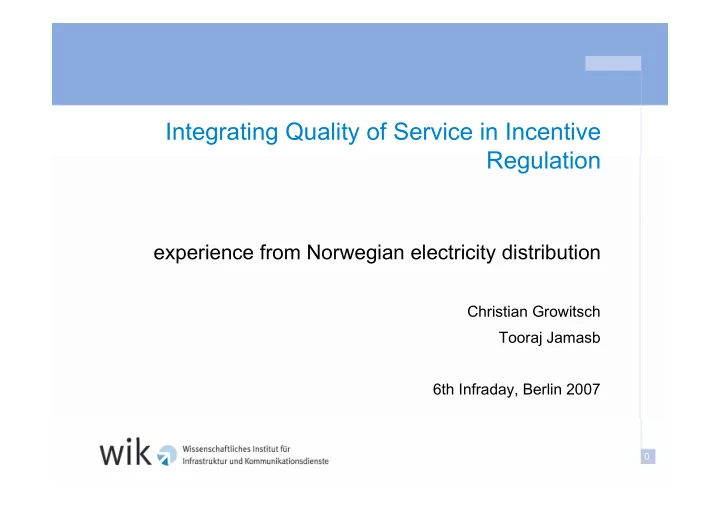

Integrating Quality of Service in Incentive Regulation experience from Norwegian electricity distribution Christian Growitsch Tooraj Jamasb 6th Infraday, Berlin 2007 0
agenda 1. Motivation and techno-economic background 2. Electricity market regulation in Norway 3. Dataset and descriptive statistics 4. Model und estimations 5. Results 6. Conclusions 1
Motivation • Incentive regulation in ESI since 1990ies • Aim: Separation of cost and revenues in natural monopolies (transmission and distribution networks) • Problem: negative secondary incentives due to - reduced maintenance - postponed investments → regulating quality of service: - to overcome information asymmetries: decentralised - to minimize monitoring cost: incentive compatible → ‘quality incorporated incentive regulation’ 2
techno-economic background I Quality of service in electricity distribution quality dimension quality perspective quality definition utility network redundancy number of number of commercial interruptions interruptions quality customer customer duration of duration of continuity continuity interruptions interruptions (reliability) (reliability) voltage quality Total Customer Total Customer Minutes Lost Minutes Lost 3
techno-economic background II Private vs. social cost of service quality cost Total cost Cost of interruptions CAPEX Losses Maintenance cost optimum quality of service 4
techno-economic background III p WTP MC q * quality MC: marginal cost of quality provision (network operator‘s cost) WTP: Customers‘ willingness to pay for quality of service Welfare maxisiming level of quality in equilibrium 5
Energy market regulation in Norway I Market structure: • Organisational (Statkraft) or accounting separation of generation and networks • Wholesale market ‘Nord Pool’ • currently 131 distribution utilities - Approx. 20,000 customers on average - Publicly owned Regulation: • 1991: market liberalisation • 1997: Introduction RPI-X revenue cap - General X-Factor - DEA Benchmarking for company individual X-Factor 6
Energy market regulation in Norway II • 2001: Introduction ‘Cost of Energy Not Supplied - CENS’ • Aim: avoiding the incentives of cost reductions by quality deterioration by internalising external cost of quality • Mechanism: - Calculation of CENS: • WTP via surveys, • Differentiated by customer groups - Estimation of expected energy not supplied with regard to environmental variables (geographical and climate data) - ‘allowed revenue’ increase/decreases by the difference of actual and expected CENS → cost savings weighted against revenue reductions 7
Data set and descriptive statistics 131 No. of companies 4 No. of periods mean min. max. Inputs Social Cost in € 9,168,757 € 248,862 € 191,866,920 € Cost of Energy Not Supplied (CENS) in € 280,780 € 0 € 10,615,560 € TOTEX in € 8,887,977 € 248,862 € 187,337,280 € Outputs Delivered energy in MWh 523,230 7,470 15,482,385 Total number of customers 19,783 429 516,339 8
Correlation analysis environmental variables TOTEX Actual CENS Geo-Index1 0.8990 Geo-Index1 0.8227 Geo-Index2 0.9016 Geo-Index2 0.8238 Forest HV 0.8476 Forest HV 0.7252 Temperature HV 0.6637 Temperature HV 0.7201 Slope HV 0.7666 Slope HV 0.6815 z6 0.7067 z6 0.7428 Wind HV 0.6733 Wind HV 0.5634 Wind by sea dist. 0.2330 Wind by sea dist. 0.1490 Density HV 0.8533 Density HV 0.7987 Microgeneration 0.4959 Microgeneration 0.4308 Seacable 0.2883 Seacable 0.2692 9
Model ( ) − = ln CENS it 1 α + α + α + α 2 ln ln ln( ) ENERGY CUSTOMERS ENERGY 0 1 it 2 it 11 it 2 1 + α + α 2 ln CUSTOMERS ln ENERGY * ln customers 22 it 12 it it 2 1 TOTEX TOTEX TOTEX + β + β + δ 2 ln( ) ln( ) ( ) * ln ENERGY 1 11 1 it 2 CENS CENS CENS it it it TOTEX + δ + τ + τ 2 ( ) * ln CUSTOMERS t t 2 it 1 2 CENS it + θ + θ + θ + θ + θ + − * * * * * z z z z z v u 1 1 2 5 3 6 4 7 5 8 it it 10
Estimation -ln (CENS) = -0.0695*** ln Customer -0.2785*** t t 2 ln Energy -0.3483*** 0.0274*** ½ (ln Customer) 2 -0.1624*** ½ (ln Energy) 2 -0.3550*** ln Customer * ln Energy -0.2497*** -0.4546*** ln TOTEX 0.9515*** Geo-Index 1 ½ (ln TOTEX)2 0.0064*** Hail 0.0679*** ln TOTEX * ln Customer -0.0069*** z6 0.0105*** ln TOTEX * ln Energy 0.0032*** Wind HV 0.0582*** Constant 0.3925*** Wind by sea dist. -0.0374*** N 131 T 4*** Wald Chi 2 Log-likelihood 511.02989 98473.6*** 11
Results • Environmental variables: - Influence productions cost more than CENS (multivariate) - Highly correlated → estimation of ENS might be misspecified - translog-setting: hardly significant • TOTEX and CENS are substitutes • Private und social cost have increased over time • Average efficiency remained constant 12
Conclusions • The introduction of CENS has not changed the network operator’s average efficiency • CENS remained constant over time: Quality of service has not been increased • but did not deteriorate either Prospect research: • Increase panel duration • Analysis of relation TOTEX and CENS: substitution elasticity 13
wik GmbH Wissenschaftliches Institut für Infrastruktur und Kommunikationsdienste Dr. Christian Growitsch Head of department Energy markets and energy regulation p.o. box 2000 53588 Bad Honnef Tel 02224-9225-88 Fax 02224-9225-68 eMail c.growitsch@wik.org www. wik. org
Recommend
More recommend